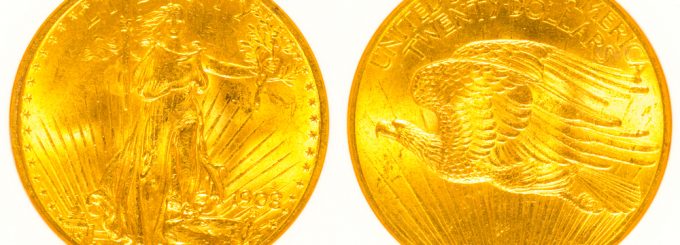Gold Coin Spotlight: 1907 Saint Gaudens $20

The $20 Saint Gaudens Double Eagle has been widely considered one of the most coveted gold coins by collectors, due to its incredible beauty and increasing rarity. It was struck by the American Mint between 1907 and 1933 and is named in honor of the designer, Augustus Saint-Gaudens.
Origins
This coin is the result of efforts by U.S. President Theodore Roosevelt to create more beautiful American coinage. He believed correctly that Augustus Saint-Gaudens was the man who could get the job done, and he certainly did.
Sadly, Saint-Gaudens passed away prior to his designs being unveiled in physical form, but the coin was and is an American classic, and it is said that the high relief made it very challenging to strike. However, the chief mint engraver at the time, Charles Barber came up with some design modifications that made it possible for the coin to be struck with one blow.
The value for these coins may vary greatly depending on its general condition and mint year. For instance, a Saint Gaudens from 1907 that is in solid condition may sell for over four figures which is currently the price for an ounce of gold. However, rarer specimens such as the Saint Gaudens 1908-S that has a grade of uncirculated could easily fetch five figures.
There are other factors that should be considered. For example, when examining a Saint Gaudens Double Eagle, start with a reference point, such as the torch which Lady Liberty holds. If you notice that the torch appears worn down or seems greatly eroded, this means the coin would probably only be given a good rating.
Features
However, for Saint Gaudens Double Eagles like the one sold here on Coin Exchange NY, which have a torch that is not worn down, this means that the coin is in much better condition, so much so that it has been given a PCGS MS63 grade, as it is in uncirculated condition. This is why it is highly recommended to always have your coins graded via a professional.
By doing so, you’ll have a better understanding regarding a coin’s condition as well as its fair market price. Though grading can be an intensive process that takes into account every imperfection, even the minor ones, it gives coin collectors peace of mind, since the metallic content and authenticity will be officially verified.
A final factor that should always be taken into consideration is the mintmark, as this informs you of where the coin was struck. In the case of the Saint Gaudens Double Eagle, its mintmark is visible on the reverse side, just beneath the date. If you see the letter “D”, this means the coin was struck in Denver. If you see the letter “S,” this means the coin was struck at the Mint of San Francisco. If you don’t see a mintmark, this means the coin was probably struck in Philadelphia, which didn’t use one. Depending on the mintmark that a coin has, this can greatly increase its value.


